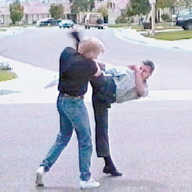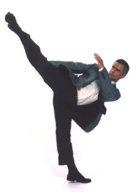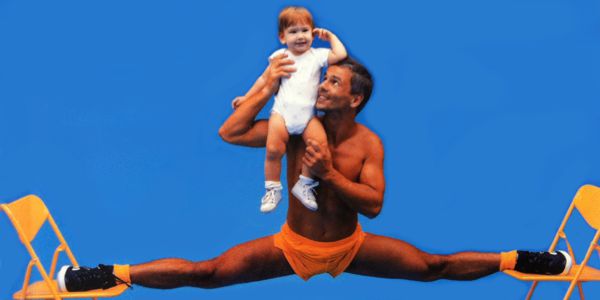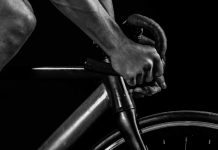High Kicks with No Warm-Up: The Right Body Alignment for Great Height and Power in the Roundhouse Kicks
This is the seventh installment of my column on training that appeared in January 2000 issue of TaeKwonDo Times.
To read the previous installment click here.
To throw powerful roundhouse high kicks with no warm up you need to align your body as follows:
1. The thigh of your kicking leg and your spine viewed from above lie along one line (are in one plane).
2. Toes of your supporting foot point away from your target—they are at about 135° or more from the line formed by your kicking leg.
3. The line of sight from your eye to your target goes just in front of the shoulder (right shoulder for the right kick, left shoulder for the left kick), over your hip and extended kicking leg.
4. The arm on the same side as the kicking leg drops behind your back. The arm on the side of the supporting leg protects your face.
5. The higher you kick, the higher you should chamber your kicking leg (in other words, raise your flexed leg so its knee points at or above your target) and the lower you should drop your trunk. Your kicking leg and your trunk are the two pans of a scale, balancing on your supporting leg. The lower you lean your trunk, the higher you can raise your chambered kicking leg. When beginning to learn the high roundhouse kick, you may need to lean your trunk so low that your head is below your hips. With practice you will reduce the amount of this lean.


Body alignment in the high roundhouse kick demonstrated by Thomas Kurz (on the left) and Mac Mierzejewski, author of Power High Kick with No Warm-Up! (on the right)
Now the details of movement:
While planting the supporting foot, move your whole body forward. When you start the pivot on your supporting foot, throw your flexed leg and its hip at the target—straight at the target, not to the side. Chambering by lifting the thigh to the side causes hip pain and possible inflammation. The reasons are explained in the previous article on the side kick.
Chamber as if aiming higher than you need to for a given target. Either an insufficiently high chamber or lowering the knee while the lower leg is thrown at the target can cause pain at side of the knee.
At the highest point of your chamber start an inward rotation of the thigh of your kicking leg. The inward rotation of the kicking leg in the roundhouse kick is essential for transferring most of your force to the target—without it your kick would be a mere glancing blow—and to spare your kneecap from getting sore. This inward rotation depends on the outward rotation of the thigh of your supporting leg—the more outward you rotate your supporting leg (so your toes point at a wider angle away from the target) the greater is the inward rotation of the thigh of your kicking leg.
Is it safe for someone who has only read this description and watched people kick, to go and practice the high roundhouse kick? No.
Before learning this kick you must master several other techniques that are lead-up skills for the high roundhouse kick. The movement habits as well as strength and muscular endurance acquired while drilling these lead-up skills will make learning the roundhouse kick easy and protect you from injuries. Here is the sequence of these skills:
1. Straight punch—to acquire the habit of rotating and counterrotating hips and shoulders. Also, people who have not mastered straight punches put their arms in weird positions during the roundhouse kick.
2. High front knee kick—to develop the habit of high chamber and putting the hip into the kick.
3. Groin kick (kin geri in karate)—teaches flicking the lower leg without overextending its knee and returning the foot back so the heel contacts the buttock. All this happens without lowering the knee below its chambered position.
4. Front thrust kick—to acquire the habit of throwing the hip toward the target and rotating and counterrotating hips and shoulders with arms.
5. Side thrust kick—to acquire the habit of turning the supporting foot away from the target, committing the hip into the kick in a greater measure than in the front kick, plus leaning the trunk away from the target while the whole body moves toward it. It also reinforces the habit of high chamber.
These skills should be taught in the sequence given above. Each skill should be mastered to the point of being stable and reliable in contact sparring (except the groin kick, of course, which is forbidden in any kind of sparring), even under great fatigue, before the next skill is taught.
Leg raises to the front and back may be practiced right from the beginning of one’s training to increase range of motion in the movements making up the high roundhouse kick. The leg raise to the side, which was described in the previous article, “High Kicks with No Warm-Up: The Right Body Alignment for Great Height and Power in the Side Kicks,” helps in finding the position of the hip joint that permits greater side mobility while keeping the trunk high enough for instantaneously regaining the upright position you need for punching.
Now you know how to align your body for great height and power in the roundhouse kick without having to reach the limits of the range of motion in your hip joints. To throw high roundhouse kicks without any warm-up, you have to develop your dynamic flexibility (see my article “Right Stretches for High Kicks with No Warm-Up”) and master the lead-up skills prior to practicing the roundhouse kick.
References
Kurz, T. 1994. Stretching Scientifically Island Pond, VT: Stadion Publishing Co. Inc.
Mierzejewski, M. 1996. Power High Kicks with No Warm-Up! Island Pond, VT: Stadion Publishing Co. Inc.
This article is based on the book Stretching Scientifically and the video Power High Kicks with No Warm-Up!. Get the book and the video now and have all of the info—not just the crumbs!










